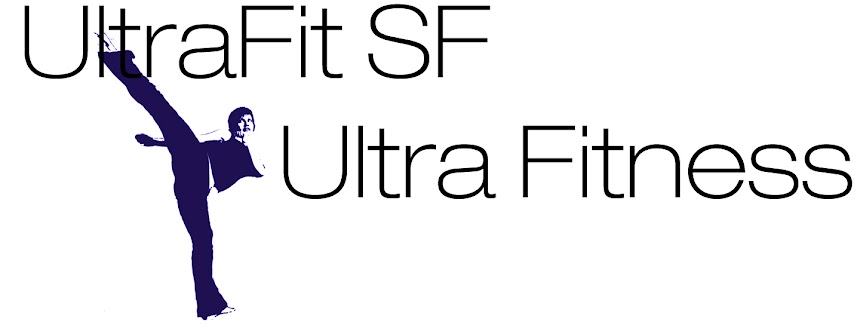Thursday, June 24, 2010
Oblique Crunches with a Partner
Partner Exercise - Push-Up Contest
Partner Squats
Six-Pack BOSU
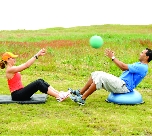
Start by sitting on the BOSU trainer in a semi-reclined position. Be sure to keep your abdominals very tight throughout the entire drill. Your partner sits facing you. He or she throws the ball to you, and you catch it and throw it back. Your partner’s goal is to try to get you to lift one foot off the ground or to touch down with one of your hands. He or she can make the exercise more difficult by throwing the ball slightly off to one side, trying to put you off balance. Every time one of your feet lifts or your hand touches down, your partner gets a point. Play the game for 1.5 minutes and then switch. This is a great drill for developing abdominal strength and core stability.
King of the BOSU
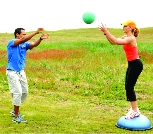
Stand on the BOSU trainer. Your partner stands on the floor holding a medicine ball. Again, his or her goal is to put you off balance so you touch down. The drill begins with your partner throwing the ball to you; you catch it and throw it back. Your partner can circle around you, leading you in one direction and then the other. You follow your partner by adjusting your feet and continuing to catch and throw the ball. Every time one of your feet touches down, your partner gets a point. Play the game for 2 minutes and then switch. This is another great drill for developing balance and stability.
Survivor BOSU
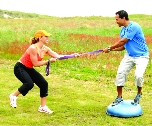
Stand on the BOSU trainer. Your partner stands on the floor on one leg. Each of you holds one end of a rope. The only rule is that neither of you can let go of the rope. The goal of this game is for your partner to get you to touch one foot down to the ground. Of course, you are trying to make sure this doesn’t happen. Every time one of your feet touches down, your partner gets a point. Play the game for 2 minutes and then switch. This partner exercise is great for developing balance and stability.
Squat and Overhead Press Throw to Partner with a Medicine Ball

Start by standing 5–6 feet away from your partner. Hold the medicine ball at chest level. Using an overhead press, toss the ball to your partner. Stay square to your partner. Your partner should catch the ball in an overhead position. Be sure to keep your abdominals contracted, your chest out and up, and your shoulders back and down. Continue for 30–90 seconds.
Variations: Try throwing the ball in different directions so your partner moves around to catch it (e.g., toss the ball side to side).
V-Sits With Rotation and Pass to Partner with a Medicine Ball

Sit on the floor about 1–2 feet away from your partner with your knees bent. Sit upright with perfect posture, abdominals contracted tightly throughout the entire exercise. Start by holding the medicine ball into your chest. Now you and your partner recline back a few inches while maintaining perfect posture. Hold that position as you both rotate one way and then the other. Return to the starting position and, once you’re upright, throw the ball to your partner. Your partner will catch it, and you’ll both repeat the exercise. Repeat for 30–90 seconds.
Variations: Try facing the same direction and tossing the ball laterally to your partner.
Partner Sprint and Roll with a Medicine Ball

Stand side-by-side with your partner. Start by rolling the ball forward on a diagonal so that it will intersect your partner’s path. You and your partner both sprint forward. Your partner catches up to the ball and rolls it forward and diagonally into your path. Continue sprinting and rolling for 60–120 seconds, going each way.
Partner Side Swing Pass - Medicine Ball Exercise

Stand side-by-side about 2 feet from your partner. Maintain perfect posture and keep your abdominals contracted throughout the entire exercise. Keep your arms straight and swing the ball from the outside of your body to the inside; then toss the ball to your partner. Your outside leg will pivot as you rotate across your body. Your partner catches the ball and repeats the exercise. Continue for 30–90 seconds each side.
Lunge and Chest Pass to Partner with a Medicine Ball
 Start by standing tall with perfect posture, facing your partner. Lunge forward as you throw the medicine ball to your partner using a chest pass. Your partner will catch the ball while performing a backward lunge. Repeat, lunging forward and backward. Remember to push off the front leg and be sure that your front knee stays over your front foot while lunging. Continue for 30–60 seconds each side.
Start by standing tall with perfect posture, facing your partner. Lunge forward as you throw the medicine ball to your partner using a chest pass. Your partner will catch the ball while performing a backward lunge. Repeat, lunging forward and backward. Remember to push off the front leg and be sure that your front knee stays over your front foot while lunging. Continue for 30–60 seconds each side.Variations: Add a small step forward for deeper lunge progressions.
Medicine Ball Partner Shuffle Drill
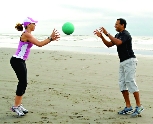
Stand facing your partner. Shuffle for about 10 feet, going one way, while simultaneously tossing the medicine ball back and forth to your partner. Repeat, going the opposite direction. Continue for 60–120 seconds.
Kneeling Partner Twist with a Medicine Ball
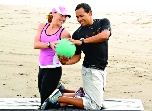
Kneel back-to-back with your partner. Keep your
abdominals contracted and maintain perfect posture. Slowly twist to one side and pass the ball off to your partner. Return to the other side to retrieve the ball. Continue for 30–90 seconds, going one way. Repeat, going the other direction.
Variations: Do this exercise while standing.
Medicine Ball Partner Chest Pass
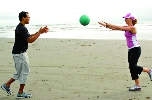
Single-Leg Partner Chest Pass. Stand facing your partner, each of you balancing on one leg. Keep your abdominals contracted and your body erect and stable. Pass the ball back and forth to each other using a basketball chest pass. Continue for 30–60 seconds on each leg.
Variations: Try hopping side to side, front and back, while passing.
Medicine Ball Partner Exercise
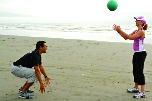
Partner Floor Slams. Start by standing upright and holding the medicine ball over your head. Keep your abdominals contracted throughout the entire exercise as you squat and throw the ball to the floor so that it bounces up toward your partner. Your partner catches the ball and quickly throws it back to you. Be sure you both maintain good posture. Continue for 60–120 seconds.
Variations: Try throwing the ball in different directions so your partner moves around to catch it (e.g., slam the ball side to side).
Tricep Kickbacks with a Partner

Triceps Kickbacks. Stand facing your partner. Wrap the tubes around each other and each hold one handle in your right and left hands. Slowly bend forward at the hip while maintaining perfect posture and a long spine. Position both of your elbows up high and keep them there throughout the entire exercise. Your elbows will act as a hinge as you and your partner slowly straighten your arms backward. Your elbows should not move out of position. Slowly return to the starting position. Complete 1 set of 8–20 reps.
Partner Upper Body Exercise

Lunge and Full-Body Rotation. Start facing sideways to your partner, holding one end of one tube in your hands. Lunge your outside leg (leg farthest away from your partner) forward while simultaneously rotating to the outside of your body. Press up and backward and do 8–20 reps one side; then repeat on the other side. Be sure that, while lunging, your front knee stays over your front foot and you always push from the leg in front. Both people lunge simultaneously.
Variations:
- Step forward (entry-level variation).
- Perform a deep lunge (more advanced variation).
Partner Trunk Rotations Using Tubing

Trunk Rotation. Stand facing your partner. Wrap the tubes around each other and each hold one handle in your right and left hands. Back away from each other until there is some light resistance on the tube. Contract your abdominals inward and maintain good posture throughout the entire exercise. Begin by rotating your torso one way while your partner rotates in the other direction. Slowly return to the starting position. Perform 8–20 reps on each side.
Variations:
- Keep the lower body static.
- Rotate/pivot through the lower body.
- Add one-arm rotation, to engage more of your upper body.
Partner Exercise Using Tubing
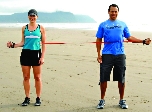
External Rotation. Stand side-by-side with your partner, facing the same direction. Each of you holds one handle of one tube in your outside arm. Your outside elbow, bent at 90 degrees, is anchored at your waist. Keeping your upper arm at your side, slowly rotate your forearm away from your body. Complete 1 set of 8–20 reps for each arm. This partner exercise strengthens weak rotator cuff muscles.
Variations: Try this exercise standing on one leg
Tubing Partner Exercises
Try these fun, effective partner exercises to build strength.

Mid-Row. Stand facing your partner. Intertwine the tubes, holding one handle each in your right and left hands. Back away from each other, arms fully extended, until there is some resistance on the tube. Begin in a squat stance with feet between hip and shoulder width apart. Slowly pull the tube, leading with your elbows, driving them backward. As you’re rowing backward, pinch your shoulder blades together and toward the ground. As you release your arms forward, squat toward the ground. Complete 1 set of 8–20 reps. This partner exercise helps improve posture.
Variations:
- Hold a static squat.
- Do single-arm rows. (Double up the tube in each arm.)
- Add rotation as you row.
Tuesday, June 22, 2010
Pet Health Pictures Slideshow: Exercising With Your Dog (Part 5)

Gentle Exercises for Older Dogs
Just because your senior dog moves with a slower, stiffer gait then when he was a pup doesn't mean he should stop exercising. Senior dogs, especially those with arthritis, not only can exercise -- in many cases, they should. Exercise helps increase flexibility and endurance, strengthens muscles around the joints, and can help stave off health problems caused by obesity. Exercise also aids bowel function, which is especially important in older dogs. And, since obesity tends to make arthritis worse, any activity that helps your dog lose weight could ease his symptoms in the long run. Try low-impact exercises such as swimming, moderate walking, or even a game of fetch with your old fellow.
Paw Protection
Long walks on rough surfaces can damage a dog's paws. Start slowly, Snyder advises. If you work your way up to longer walks, "most dogs will develop thicker pads on their feet and not have problems." On hot days, avoid prolonged contact with asphalt or sand. On snowy days, check the paws for ice build-up. And if you venture onto very rough surfaces, consider buying a pair of dog booties.
Preventing Heat Exhaustion
Just like people, dogs are susceptible to dehydration and heat exhaustion. On hot days, Snyder suggests bringing a water bottle and foldable drinking bowl or sticking to places with a public water source. Signs of dehydration in dogs include excessive panting, confusion, weakness, and collapse. Brachycephalic or short-faced breeds, such as bulldogs and boxers, are especially vulnerable because they don't pant efficiently.
Pet Health Pictures Slideshow: Exercising With Your Dog (Part 5)

Fetch
Fetching a ball or favorite toy over and over can be great exercise for your dog. But it doesn't do much for you, if you're just standing there tossing. Instead, make a game of fetch part of your home workout routine. Do lunges or abdominal crunches as you throw the ball. You might build more muscle by throwing a heavy ball, but a soft, lightweight toy is safest for your dog's mouth.
Getting Started
When making your dog your exercise buddy, step one is a trip to the vet. "A good vet evaluation is always important before changing your dog's lifestyle," Synder explains. "The veterinarian will want to evaluate your dog for any heart, lung, or other health problems." It's also important to check for signs of arthritis or musculoskeletal disease. A dog with inflamed joints or ligaments may require a low-impact exercise plan.
Establishing a Routine
Develop a workout routine that's realistic, considering your job schedule and other demands on your time. Also consider your dog's needs -- working breeds and puppies usually need a lot of exercise. Start with a short-term goal of exercising five or 10 minutes every day. Gradually work up to 30 minutes on most days of the week. Keep in mind that narrow-bodied breeds, such as Doberman pinschers, should not exercise right after meals.
Avoiding Overkill
When exercising with your dog, watch for signs that one of you may be overdoing it. You are working too hard if you can't speak comfortably. Your dog may be overworked if he is breathing fast, panting excessively, staggering, or refusing to follow you. If either of you are stiff, sore, or exhausted for hours after a workout, take it easier next time.
Pet Health Pictures Slideshow: Exercising With Your Dog (Part 4)

Rollerblading
People who enjoy rollerblading may be afraid to bring their pup along. No one wants to be yanked off the sidewalk whenever Sparky spots a squirrel. But experts say rollerblading with your leashed dog can be safe with proper training. The goal is to have your dog run right next to you without pulling on the leash. You may be able to encourage this behavior by giving her treats whenever she runs in the correct position.
Cycling
Like rollerblading, cycling safely with your dog requires special training. Teach your dog to run next to the bicycle without pulling. You may want to attach her leash to your bike with a Springer. This is a device that absorbs some of the force of your dog's tugs, which could help you keep your balance if she pulls suddenly. Keep a close eye on your dog's condition. It's easy for her to overdo it if she's running while you're on wheels.
Dog Park
To provide a chance for off-leash play, find a local dog park. Off-leash running and playing lets your dog set his own pace, so he can burn energy and rest when he's tired. Other perks include the chance to socialize and the mental stimulation that comes with unfettered exploration. Dog owners also get a workout trying to keep up with their pets. It's a good idea to complete some obedience training before allowing your dog off-leash.
Skijooring
Cross-country skiing offers a vigorous workout. Just 20 minutes, three days a week, may deliver as many health benefits as walking 30 minutes, five days a week. If your dog is athletic and weighs at least 30 pounds, he may qualify as your ski buddy. In skijooring, your dog is harnessed to you while you ski. Beginners should consider an introductory course with skijooring safety tips for man and beast.
Pet Health Pictures Slideshow: Exercising With Your Dog (Part 3)

Hiking
If your area offers hiking opportunities, you've got one lucky dog. "Most dogs love to go out and visit new smells, see other animals," Snyder tells WebMD, "all while spending time with their owner." Like walking, you'll need to maintain a brisk enough pace to elevate your heart rate. And if you live in an area where ticks carry Lyme disease, make sure you cover up and apply an insect repellent containing DEET -- and have your dog vaccinated. After hiking, inspect your body for ticks and do the same for your dog.
Soccer
If you're a soccer fanatic, why not make your dog a fan, too? Check your pet supply store for soccer-style exercise balls for dogs. These are made of hard plastic and come in different sizes to suit your particular breed. You kick the ball, and your dog tries to pass it back with his nose or paws. You can also use a regular soccer ball made for people -- just be careful about kicking the ball directly at your dog's face or body.

Agility Training
Agility training is another popular goal-oriented sport. Your dog races through an obstacle course with ladders, hurdles and tunnels, while you run alongside offering praise and encouragement. The fast pace provides both of you with an excellent cardiovascular workout, while your dog also develops improved coordination. Participate in organized competitions or look for a park with an agility course you can use on your own time.
Doga
Downward-dog takes on a whole new spin when you bring your dog to yoga class. "Doga" incorporates your pet into Hatha yoga poses. For example, you recline in resting pose with your legs bent over your terrier's torso. Classes are springing up across the country, but this is no fat-burner for Fido. "It should be a very nice experience for the human-animal bond," Snyder says, "but I'm not sure I'd consider it a valid exercise plan for dogs."
Pet Health Pictures Slideshow: Exercising With Your Dog (Part 2)

Jogging
Not all dogs are built to jog. Greyhounds, for example, are pros at short-distance sprinting, but can become fatigued during long-distance runs. If you want to jog with your dog, choose a breed that is suited to distance-running, such as a Labrador. Wait until your pup is full grown and then gradually build up to a 30-minute excursion. This should include five minutes of warm-up, 20 minutes of jogging, and five minutes of cooldown.

Swimming
Swimming is an all-in-one workout that is especially beneficial for people or dogs with arthritis. Because it's a low-impact sport, swimming is easy on the joints. But that doesn't mean it's a wimpy workout. Swimming works various muscle groups, improves endurance, and strengthens the heart and lungs. Not all dogs enjoy swimming, so start slowly. Use toys or treats for encouragement, and if your dog still resists, find another sport.
Frisbee
Frisbee offers a classic canine workout. You can play a relaxed game in your own yard or join a formal "Disc Dog" team. Participating in competitions may give you and your dog greater motivation to practice regularly. "Goal-oriented sports are great," says Synder, "because they not only allow the dog to exercise, but also are a fun activity that allows for continued behavior training and contributes to the owner-pet bond."
Pet Health Pictures Slideshow: Exercising With Your Dog

Dogged by Obesity
Man's best friend is battling one of man's worst enemies -- obesity. Up to 40% of dogs in the U.S. weigh too much. Like people, overweight dogs are at risk for health problems, from arthritis to heart disease. This is one challenge you and your pet can face together. Research suggests people who exercise with their dogs are more likely to stick to a fitness program. The key is finding activities you both enjoy.
Walking
Brisk walking is an ideal exercise for human and hound. The benefits include a stronger heart, lower blood pressure, more energy, denser bones, and a lower risk of depression. In dogs, regular walks can also reduce common behavior problems. "There's no set rule for how far a dog should walk," says Kathy Snyder, DVM, of Texas A&M University. "Just work slowly toward a goal with a gradual increase in the speed and length of walks." A trip to the vet for your dog and a doctor's checkup for you is recommended before starting an exercise program.
Dancing
If long walks don't entice you, try dancing with your dog. Also called musical freestyle, you choreograph a dance routine to upbeat music. You'll have your pooch running between your legs and performing other tricks, while both of you get an aerobic workout. The benefits of dance include burning calories and developing greater stamina, better balance, lower blood pressure, and improved muscle tone and bone density.
The Top 20 Fitness Mistakes Beginners Make

Don't let exercise errors stand in your way
By Leanna Skarnulis
WebMD Weight Loss Clinic - Feature
Reviewed By Kathleen Zelman, MPH, RD/LD
Are you exercising regularly, yet not seeing the results you want? Or getting sidelined by pulled muscles and other injuries? Feeling tempted to drop out because you're so bored?
Don't give up your fitness program just yet. Maybe the problem isn't the exercise itself but the way you're exercising.
Exercisers (especially beginning exercisers) often make mistakes that keep them from getting the most from their workouts. Fitness experts spoke to WebMD about 20 of the most common exercise mistakes, and how you can keep them from derailing your fitness program.
Cardio Uh-Ohs
1. Doing the "gym slouch." "We see many people in the gym leaning on equipment," says Debi Pillarella, MEd, a spokeswoman for the American Council on Exercise. "We call it 'gym slouch': They're on the Stairmaster, [elliptical cross trainer], or treadmill, leaning over, and hanging on for dear life."
When your back is rounded, your spine doesn't get enough support. So stand erect when you're working out on one of these machines. (Also, you aren't working hard enough with the slouch. Stand erect and get the most out of your cardio workout).
2. Getting a grip. Holding on too tightly to the cardio equipment lets you "cheat" and contributes to slouching. It also keeps you from moving your arms -- which can boost your heart rate and burn extra calories. If loosening your grip makes you feel insecure, try this technique Pillarella teaches at Community Hospital Fitness Pointe in Munster, Ind. "Instead of gripping, just rest your fingers, from your index finger to the pinkie, on the bars. As you get more comfortable, drop a finger. Eventually, you may have just the index fingers resting there for security."
3. Catching up on your reading. If you're doing lots of reading on the elliptical machine, you're probably not getting a good workout, says Julie Isphording, host of the radio shows Fitness Information Talk and On Your Feet.
"If you must read, stop about every three minutes and do a four-minute focus interval," she says. During this interval, "concentrate on picking up the pace, dropping your shoulders, breathing, and using your arms." (This is a great piece of advice. However, you can get a better work out by not reading and doing a shorter period of cardio with more intensity).
4. Walking with weights. Carrying hand weights when you walk might seem like a good way to add strength training to your cardio workout, but it compromises your stride. "You lean forward, and it stresses the quads, ankles, and shins, and can cause stress fractures," Isphording says. "Keep your cardio and strength training separate."
5. Thinking cardio is enough. Many people think they need only a cardiovascular exercise program. "We begin losing muscle at age 30," says Isphording. "Strength training builds muscles, which increases metabolism and burns more calories."
Strength-Training Slipups
6. Rushing your reps. Doing weight-lifting repetitions too fast raises your blood pressure and increases your risk for joint injury. It also compromises your results.
"The safest way to use strength machines or dumbbells is: in lifting phase, exhale for two counts and hold briefly at the top of the contraction, then return as you inhale for four counts," says Pillarella. "Always exhale during the hardest part of the work."
7. Giving your abs a free ride. Many people do crunches or abdominal machine workouts without ever toning their abdomens. The problem is that they're using the upper torso, neck, and head to do the work.
"Do mindful exercise," says Pillarella. "The contraction should be from the ribcage to the hip bone. Put your mind into the muscles that are working, and keep all the other muscles quiet."
8. Doing lackluster lat pull-downs. On this machine, you're seated with a bar overhead. Some people stick their heads forward and pull the bar down behind their heads. But doing it this way could injure your spine or neck -- and your back won't get that coveted "V" look.
Instead, "pull the bar down in front of your shoulders and chest, and put your mind into muscle contractions in your back," says Pillarella.
9. Using maladjusted machines. Weight machines are made for people of all shapes and sizes. You must adjust them to fit if you want to get results and avoid injury.
For example, using an improperly set leg-extension machine puts stress on your knees, says Mark Kasper, EdD, a spokesman for the American College of Sports Medicine. "Another problem with improperly adjusted machines is that you don't work your muscles through the full range of motion," he says.
Have a qualified trainer show you the proper settings for your physique, and write them down on a card that you carry to the gym.
Flexibility Flubs
10. Stretching cold muscles. Stretching before your workout puts you at risk for pulled or torn muscles. "Always stretch at the end of your workout," says Pillarella.
11. Bouncing. Bouncing during a stretch can increase your risk of straining or pulling muscles, Pillarella says. Instead, "hold a static stretch with no movement at the joints. Your body should feel lengthened but not to the point of pain."
Routine Maintenance
12. Forgetting about fun. "If you're bored with your routine, and your treadmill has faced the washer since 1980, how much fun is that?" says Isphording, "I'd never want to do your workout, either. ? And why do we call it a workout? It should be a playout."
Exercise with your friends or family, just as you go to movies or dinner with people. "Unless we reframe it in our minds, it will never be fun," Isphording says.
13. Doing outdated exercises. Still doing the exercises you learned in high school, like windmills and leg lifts? Some of these oldies are a waste of time; others can cause injury. Take an exercise class or work with a personal trainer to freshen your routine.
14. Getting stuck in a rut. What's wrong with doing the same exercise routine, day in and day out? "You're working the same muscles, going at the same speed, and once you get in shape you no longer breathe heavily," says Isphording. "The muscles become very efficient. They expend less energy, and you burn fewer calories."
Find different types of exercise that you enjoy, and make it a point to vary what you do.
15. Seeking a quick fix. Many people expect dramatic results from a little exercise. "Current recommendations are for 3 1/2 to four hours of physical activity a week just to prevent weight regain," says Kasper, who is a professor in the department of kinesiology at Valdosta State University in Valdosta, Ga. "If you want to lose weight and you're walking 30 minutes, three times a week, without changing your diet, it will take roughly one month to lose a pound."
Want to lose faster? Exercise more.
16. Being a weekend warrior. "If you're only exercising two days a week, you'll never get where you want to be, and you'll feel awful every Monday," says Isphording. "It leads to injury and burnout, and you're missing the secret to success: showing up."
17. Taking on too much at first. "Whether on a treadmill at home or working out at an exercise facility, people tend to do too much too soon," says Kasper. "They put themselves at risk for an orthopaedic injury."
He advises working with a qualified trainer who will do a screening, teach proper techniques, and set up an appropriate fitness program.
Sins of Omission
18. Skipping the warm-up. "Without a warmup, you're asking your body to work before the oxygen and blood flow reach the muscles," says Pillarella. "You increase the risk for injury, and with cardiovascular exercise, you raise the heart rate too fast. Before you exercise in earnest, spend 5-10 minutes going through the motions of your workout at an easy pace to raise your body temperature from the inside out."
If you don't warm up before lifting weights, meanwhile, you risk torn muscles and won't be able to lift as much weight, says Isphording. Get your blood flowing by spending a few minutes on the treadmill or exercise bike, or even walking in place.
19. Forgoing the cool-down. Don't come to sudden stop at the end of your workout. "If you don't cool down, you risk muscle soreness because you haven't flushed the lactic acid out of your system," says Isphording. "It takes five to 10 minutes at a slower pace, depending on your fitness level, to let your heart rate come down."
20. Skimping on water. Muscles need fluid to contract properly, so if you don't drink enough, you can get muscle spasms or aches.
"If you're thirsty, you're already a percent dehydrated," says Pillarella. "Drink water before, during, and after exercise."
And, Pillarella says, "unless you're a high-intensity athlete who's depleting electrolytes and potassium, you don't need Gatorade. Water is the preferred drink."
Originally published Oct. 13, 2004.
Medically updated Oct. 7, 2005.
SOURCES: Julie Isphording, host, Fitness Information Talk and On Your Feet. Mark Kasper, EdD, spokesman, American College of Sports Medicine; professor, department of kinesiology, Valdosta State University, Valdosta, Ga. Debi Pillarella, MEd, spokeswoman, American Council on Exercise; program manager, Community Hospital Fitness Pointe, Munster, Ind.
©2005 WebMD Inc. All rights reserved.
Thursday, June 17, 2010
Healthy eating made easy



Help control your weight with these four everyday tips.
- First, focus on the purpose of food: Food is the fuel that keeps your body running. And to keep your body functioning well—with plenty of energy for all the activities you love—you need to take in high-quality fuel.
- Add a fruit or vegetable to every meal. Enjoy apple slices with breakfast. Pack a snack of grapes in your lunch. Add a serving of broccoli to your dinner. You'll benefit from the vitamins and minerals this extra serving of health contains, and your stomach will be satisfied by these filling foods.
- Drink more water. Your body needs this essential nutrient. Plus, drinking water is a good way to manage your hunger rather than reaching for unhealthy snacks. Let thirst be your guide for fluid intake, but you'll need more if you are active or are in very hot or very cold climates.
- Avoid foods with high amounts of fat, sugar, and salt. Foods high in these three ingredients alter the brain’s chemistry in such a way that makes you want to overeat them. Former FDA commissioner David Kessler, MD, calls this response “conditioned hypereating”: “conditioned” because our desire to eat these foods becomes automatic, even when we’re not hungry; and “hyper” because we eat these foods in excess, often unable to control how much we eat.
Friday, June 11, 2010
Hypertension/High Blood Pressure Health Center
 High Blood Pressure and the DASH Diet
High Blood Pressure and the DASH Diet One step to lower high blood pressure -- incorporate the DASH diet into your lifestyle. Doctors recommend:
- Eating more fruits, vegetables, and low-fat dairy foods
- Cutting back on foods that are high in saturated fat, cholesterol, and total fat
- Eating more whole grain products, fish, poultry, and nuts
- Eating less red meat and sweets
- Eating foods that are rich in magnesium, potassium, and calcium
The DASH diet, which stands for Dietary Approaches to Stop Hypertension, is an example of such an eating plan. In studies, patients who were on the DASH diet reduced their blood pressure within two weeks. Another diet -- DASH-Sodium -- calls for reducing sodium (salt) to 1,500 mg a day (about 2/3 teaspoon). Studies of patients on the DASH-Sodium plan significantly lowered their blood pressure.
Starting the DASH Diet
The DASH diet calls for a certain number of servings daily from various food groups. The number of servings you require may vary, depending on your caloric need. When beginning the diet, start slowly and make gradual changes. Consider adopting a diet plan that allows 2,400 milligrams of salt per day (about 1 teaspoon) and then once your body has adjusted to the diet further lower your salt intake to 1,500 mg per day (about 2/3 teaspoon). These amounts include all salt consumed, including that in food products, used in cooking, and added at the table.
Here are some tips to get you started on the DASH diet:
- Add a serving of vegetables at lunch and at dinner.
- Add a serving of fruit to your meals or as a snack. Canned and dried fruits are easy to use.
- Use only half the butter, margarine, or salad dressing, and use low-fat or fat-free condiments.
- Drink low-fat or skim dairy products three times a day.
- Limit meat to six ounces a day. Try eating some vegetarian meals.
- Add more vegetables, rice, pasta, and dry beans to your diet.
- Instead of typical snacks (chips, etc.), eat unsalted pretzels or nuts, raisins, graham crackers, low-fat and fat-free yogurt and frozen yogurt; unsalted plain popcorn with no butter, and raw vegetables.
- Read food labels carefully to choose products that are lower in sodium.
Staying on the DASH Diet
The following is a list of food groups and suggested serving amounts for the DASH diet:
- Grains: 7-8 daily servings
- Vegetables: 4-5 daily servings
- Fruits: 4-5 daily servings
- Low-fat or fat-free dairy products: 2-3 daily servings
- Meat, poultry and fish: 2 or less daily servings
- Nuts, seeds, and dry beans: 4-5 servings per week
- Fats and oils: 2-3 daily servings
- Sweets: try to limit to less than 5 servings per week
How Much Is a Serving?
When you're trying to follow a healthy eating plan, it may help to know how much of a certain kind of food is considered a "serving." The following table offers some examples.
| SERVING SIZES |
| Food/amount |
| 1/2 cup cooked rice or pasta |
| 1 slice bread |
| 1 cup raw vegetables or fruit |
| 1/2 cup cooked vegetables or fruit |
| 8oz. of milk |
| 1 teaspoon olive oil |
| 3 ounces cooked meat |
| 3 ounces tofu |
Foods to Fight Fatigue

The Weight of Water
Two-thirds of the human body is made up of water. Without it, we could only live a few days. The fluid helps control body temperature through sweat, moves food through the intestines, and greases the joints. It is also an essential ingredient in the production of energy molecules.
"Dehydration is one of the leading causes of a lack of energy," says Grotto. If you're not well hydrated, your body puts its resources into maintaining your water balance instead of into giving you energy.
Everyone's water needs vary. In February 2004, the Institute of Medicine released a report indicating most people meet their daily hydration needs by using thirst as their guide. In general, the Institute's expert panel recommended that women get about 11 cups of water from food and drink each day, and men get about 16 cups daily. This may seem like a lot of liquid, but 80% of it usually comes from drinking water and other beverages. The other 20% comes from food.
To adequately get your hydration needs, particularly on a hot and humid day, the American Dietetic Association suggests carrying around a bottle of water, or replacing your afternoon soft drink with water. Frozen juice bars or icy treats are also a good idea.
Water is especially important after exercise, with certain medicines, and with a high-fiber diet. Your fluid intake should be adjusted to how much water you're losing, says Finley. "Simple things like stopping at a drinking fountain when you walk by one is a good idea."
Caffeine Fix
More than half of Americans reach for a coffee cup every day, and 25% drink it occasionally, reports the National Coffee Association. This should come as no surprise, as there are those who swear they cannot function without the caffeine.
The compound can be found not only in coffee, but in tea, soft drinks, chocolate, and herbs as well.
John Allred, PhD, a food science communicator for the Institute of Food Technologists, says stimulants like caffeine exaggerate the effect of natural hormones like adrenaline. "They get your heart pumping faster, you respire faster, and that gives you a stimulated feeling," he says, noting the results usually last no more than two hours.
Psychology tests have shown a combination of caffeine and sugar can improve alertness and performance. "But then it wears off, and then you get a little bit of a slump afterward," says Camire. The high-low effect of caffeine, she says, is not as pronounced as it is in sugar, but is significant enough in that frequent users often experience headaches without the substance.
The chemical is, indeed, so potent a stimulant that the National Collegiate Athletic Association (NCAA) lists caffeine as one of its banned drugs, as long as the concentration in a urine sample exceeds 15 micrograms per milliliter. (Two cups of black coffee will produce urine levels of approximately 3 to 6 micrograms per milliliter, according to the National Center for Drug Free Sport.)
The effect of caffeine varies from person to person. Some people need a few cups before experiencing stimulation, while others feel shaky or jittery with one serving.
Caffeine can also interfere with sleep, particularly if it is consumed in the late afternoon. The lack of shuteye could obviously affect one's energy level. To resolve this issue, Camire recommends switching to decaffeinated beverages by about 3 p.m. She also suggests gradually cutting back on caffeinated drinks, especially since they may have a dehydrating effect.
Beating the Doldrums
Food can, indeed, raise or diminish the body's energy levels. If you are eating healthy and are still tired, try changing the frequency of your meals. Some people find they get more of a boost with several small meals throughout the day, while others prefer the dining concept of three square meals daily. There's no right or wrong way, says Sandquist, noting that everyone's energy needs differ.
The amount of food you eat can also make a difference. If someone overeats constantly, they tend to gain more weight and become lethargic, says Finley. "It's like the snowball rolling down the hill," he explains. "As [overeaters] get more overweight, they have less energy, and then they exercise less and don't burn the calories."
Other dietary reasons for fatigue include too much alcohol (which is a depressant) and lack of certain vitamins and minerals. Low iron is a common problem for women.
If you still find yourself sluggish with a well-balanced diet, then a visit to the doctor may be in order. Certain diseases, medications, stress, and inadequate sleep and exercise can contribute to fatigue.
Fight Fatigue With Energy Foods
 Fat Force
Fat Force Fat has also gotten a bad reputation, and for good reason. Too much of the "bad" fats is associated with heart disease, some types of cancer, and some chronic illnesses. The right types of fat and the amount, however, can make food taste good, and is a concentrated source of energy. Saturated fat (found in foods like meat, butter, lard, and cream) and trans fat (found in baked goods, snack foods, fried foods, and margarines) have been shown to increase the risk for heart disease. Replacing saturated and trans fat in your diet with unsaturated fat (found in foods like olive oil, avocados, nuts, and canola oil) has been shown to decrease the risk of developing heart disease.
In order to strike the right balance, choose polyunsaturated fats such as vegetable oils and seafood, and monounsaturated fats such as olive oil, nuts, and seeds. The unsaturated variety can help lower "bad" LDL cholesterol.
Protein Power
Fats and carbohydrates may supply the body with energy, but protein helps regulate the release of that power. Protein maintains cells, assists in growth , transports hormones and vitamins, and preserves lean muscle mass. Muscles and many hormones are, in fact, made up of protein. We need proteins for our immune system. So replenishing the body's source of the nutrient is very important.
Good sources of protein include meat, poultry, fish, eggs, beans, nuts, and low-fat dairy products.When we eat these types of foods, our body breaks down the protein that they contain into amino acids (the building blocks of proteins). Some amino acids are essential, which means that we need to get them from our diet, and others are nonessential, which means that our body can make them. Protein that comes from animal sources contains all of the essential amino acids that we need. Plant sources of protein, on the other hand, do not contain all of the essential amino acids.
In diets where the body does not get its usual fuel of carbohydrates and fat, protein provides the body energy.
Fight Fatigue With Energy Foods

Foods to Fight Fatigue
WebMD Feature
Tired. Drained. Pooped. No matter how you put it, you're beat and need to drum up some energy. You are not alone. Many people have trouble getting in gear in the morning, experience the afternoon slump, or just want to crash on the couch in the evening.
The exhaustion can be a constant problem for some folks. Fatigue is a common complaint associated with many factors. It is found in all populations and generally reported by more women than men.
Sluggishness can be caused by many factors, but experts say poor nutrition is a big culprit. A well-balanced diet, on the other hand, can boost energy.
"Food is truly our body's fuel," says Cindy Moore, MSRD, director of nutrition therapy for The Cleveland Clinic. "What we choose as our fuel is going to absolutely impact the performance of our bodies."
How do we fill up our personal tanks, and how well do they make our engine run? The experts weigh in on how major food and drink sources and habits affect energy levels.
The Forgotten Meal
At the beginning of the day, most people dash off to work or school without a thought to their body's dietary needs. Who has time to eat in the morning anyway?
"Breakfast is an easy meal to forget," says Mary Ellen Camire, PhD, professor of food science and human nutrition at the University of Maine. "But if people are skipping breakfast and find they're tired by midmorning, then it's time to re-evaluate that eating habit."
Research shows breakfast improves alertness and concentration, helps shed pounds by preventing overeating during the day, and prevents obesity, diabetes, and heart disease.
To get these benefits and to prepare the body for the day, the American Dietetic Association recommends carbohydrates for energy and protein for endurance. Some quick options include:
Whole grain bagel with cheese
- Cereal with fruit and yogurt
- Whole-grain toast with peanut butter and fruit
- Hard-boiled egg sliced into a whole-wheat pita
- Scrambled eggs, toast, and fruit
- Oatmeal with raisins
For the really busy bee, Camire says choices include breakfast bars, frozen omelets and breakfast sandwiches, oatmeal packets to go, and whole-grain cereals in prepackaged plastic bowls. Be mindful, though, of the sugar and fat content of your morning meal. A study in Pediatrics found that children who ate sugary breakfasts were hungrier and ate more at lunch.
Complex Carbohydrate Charge
Healthy eating doesn't stop in the morning. A well-balanced diet throughout the day is an essential source of sustained energy.
Although carbohydrates have gotten a bad reputation, the nutrient is still the body's preferred source of energy, says Dave Grotto, RD, director of nutrition at the Block Center for Integrative Cancer Care in Evanston, Ill. Low-carb diets, he says, initially boost energy, but deplete it in the long run.
The best way to maximize the body's potential for energy is to eat a combination of complex and simple carbohydrates. Complex carbohydrates, which are slow burning, should represent the bulk of the carbohydrates we eat, says Grotto. Foods such as whole grains and starchy vegetables such as potatoes, squash, pumpkin, and carrots fall into this category.
This does not mean ignoring simple carbohydrates with a faster burn, such as the sugar fructose, found in fruits, vegetables, and honey. They can provide an immediate source of energy.
Simple sugars found in candy bars, soft drinks, and cookies can also provide a quick boost, but then a big letdown afterward.
"You are going to get a rise in energy from the original hit of the sugar, but then, particularly for diabetics, sugar can drop below the baseline where it started," says John W. Finley, associate editor of the Journal of Agriculture and Food Chemistry, a publication of the American Chemical Society. He says the peak effect of sugar normally lasts 30 minutes to an hour, depending on the dose. Anything beyond that is reportedly psychological.
Without the complex carbohydrates to sustain the blood sugars, the body loses steam. "A diet that is based in complex carbohydrates seems to have less of that peak and valley of blood sugar effect," says Grotto.
It is also important to make sure your complex carbohydrates have fiber, says Dee Sandquist, MSRD, a spokesperson for the American Dietetic Association. "Fiber helps the carbohydrates that we eat to be more slowly absorbed by the body," she says. "So, therefore, the body gets a more balanced release of energy, as opposed to the quick burst of energy."
Many processed carbohydrates such as white rice, white bread, and pasta contain little or no fiber, thus expending energy at a rapid rate. To ensure you have a food rich in fiber, check the label. A slice of bread should contain 2 to 3 grams of fiber.
Thursday, June 10, 2010
Cancer Prevention in Every Aisle
Produce Aisle Picks
Cantaloupe - a great source of carotenoids, plant chemicals that act as antioxidants shown to reduce the risk of lung cancer.
Kale and cabbage - cruciferous vegetables are widely considered to be one of the healthiest food choices you can make. Included in this family of vegetables are broccoli, cauliflower, radishes, brussels sprouts, kale, cabbage and bok choy. Cruciferous vegetables are high in vitamins, fiber, and potent anti-cancer phytochemicals.
According to the American Institute for Cancer, there is solid evidence that links cruciferous vegetables and protection against cancer. Studies have shown that this vegetable group has the ability to stop the growth of cancer cells for tumors in the breast, uterine lining, lung, colon, liver, and cervix. And studies that track the diets of people over time have found that diets high in cruciferous vegetables are linked to lower rates of prostate cancer.
It is recommended that we eat 3-5 servings of cruciferous vegetables per week. It's best to eat these veggies raw or only lightly steamed so they retain their cancer fighting phytochemicals.
Freezer Aisle Pick
Edamame (soybeans) - These cancer-fighting beans contain phytoestrogens, that may help prevent estrogen-driven cancers by binding to estrogen receptors. They are also good for the men of the household since evidence suggests the isoflavones found in soy products may help fight prostate cancer.
Cereal Aisle Pick
Whole Grain Oats - Oats have the highest proportion of soluble fiber of any grain. Fiber is rich in antioxidants, helps fight colon cancer and phenolic compounds in whole grains my help reduce the risk of certain GI cancers. Pick cereals high in folate, fiber and/or flaxseed.
Beverage Aisle Picks
Orange juice - this favorite breakfast beverage is a powerful source of folate which has been linked to lowered risk for GI and pancreatic cancer.
Green tea - green tea is lower in caffeine than coffee and can help prevent prostate cancer and possibly bladder cancer.
Pomegranate juice - this juice is extremely antioxidant-rich and helps prevent colon and prostate cancer.
Soy milk - also made from soy beans, soy milk works the same way as edamame to fight cancer.
Household Aisle Picks
Sunscreen – summer is starting, so lather on the SPF each and every time you go out in the sun to block exposure to ultraviolet rays.
Mop or damp cloth - it's important to get rid of dust without spreading it around your home. Recent evidence has shown that dust can contain carcinogens that are known to cause cancer.
Source:
Qi Mail™ The Acupuncture Newsletter
Erika Lessey Chen, L.Ac., Dipl. Ac., C.M.T
(http://www.acufinder.com/Acupuncturist/59396).
The Lotus Center
1085 Valencia Street
San Francisco, CA 94110
415-336-0577
Monday, June 07, 2010
Side to Side Lunge with Medicine Ball

The side to side lunge is a great way to warm up and strengthen the glutes, hips and thighs. Adding a medicine ball makes the exercise more intense and forces you to engage the core to keep the body in proper alignment.
- Stand with feet wide, toes out at about a 45-degree angle and hold the medicine ball or weight at chest level.
- Lunge to the right, bending the knee and taking care to keep the knee behind the toe. Touch the ball to the floor while keeping the abs engaged and the back flat (don't round the shoulders).
- Stand up, bringing the weight to the chest.
- Repeat the lunge on the left side.
- Do 1-3 sets of 10-16 reps. One rep is a lunge to the right and left.
Tips:
- Keep your knee in line with your toe as you lunge. If the knee angles in or out, adjust the angle of your toes.
- Press through the heel of you foot as you push up from the lunge to engage your glutes.
- Avoid letting the knee bend over the toe by sitting back into the heel.
